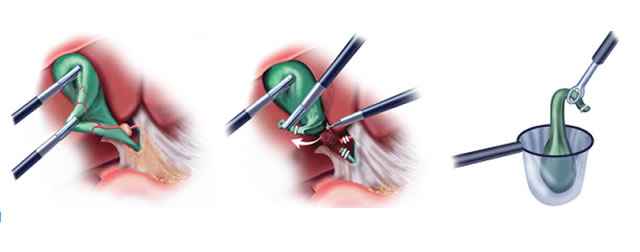Laparoscopic Surgery

Laparoscopic Surgeon In Surat
Dr. Jay Chokshi has an experience of more than 10 years of performing laparoscopic GI cancer surgeries. Whether it is treating the gall bladder, pancreas, liver, colon or any other part of gastrointestinal tract, the doctor uses minimally-invasive techniques to ensure minimal scarring and limited post-op care. For a quicker recovery after a GI laparoscopy surgery, contact South Gujarat’s more trusted surgical gastroenterologist.
Laparoscopic surgery is also called minimally-invasive surgery and keyhole surgery. In comparison to traditional open surgeries, laparoscopy is a modern technique of performing abdominal and pelvic surgeries. The procedure of a laparoscopy includes making tiny incisions (as small as 0.5 cm) with the help of a camera.
Dr. Jay Chokshi is an expert laparoscopic GI cancer surgeon. With years of laparoscopic experience, he can treat a plethora of gastrointestinal diseases and ensure faster recovery for his patients.
A laparoscopy is used for treating ailments of: gallbladder, common bile duct, appendix, small intestine, large intestine (colon), spleen, pancreas, liver, stomach, rectum and reproductive organs in the pelvic region.
WHAT ARE THE BENEFITS OF LAPAROSCOPIC SURGERY?
Today, GI surgeons such as Dr. Jay Chokshi, are choosing laparoscopic surgery because it offers several benefits in comparison to open surgeries.
- A magnified image of the patient’s body to ensure a more precise and faster surgery without damage to the adjacent organs.
- Reduction in organ exposure leads to decrease in risk of infections.
- Reduced chances of blood loss and hemorrhage.
- Smaller incisions mean reduced pain and less post-operative scarring.
- Shorter recovery time and reduced post-operate care.
- Laparoscopy can be done as an outpatient procedure, thus leading to reduction in patient cost.
WHAT TYPE OF LAPAROSCOPIC SURGERIES HELP PATIENTS WITH GI ISSUES?
Laparoscopic surgeries of the GI tract include:
1. Laparoscopic Cholecystectomy – It is a surgery to remove gallbladder especially when the patient is suffering from gall stones or even gall bladder cancer.
2. Laparoscopic Common Bile Duct Exploration – The laparoscopic surgery is used to remove stones of common bile duct.
3. Laparoscopic Hernia Surgery – Whether it is inguinal hernia, ventral hernia, incisional hernia or umbilical hernia, a laparoscopy can prove to be useful in treating the problem.
4. Laparoscopic Appendectomy – It is useful for the for surgical removal of the appendix with minimal incision and scarring.
5. Laparoscopic Heller’s Myotomy for Achalasia Cardia – Achalasia Cardia is the disorder of the esophagus which make the passage of food and liquid into the stomach difficult.
6. Laparoscopic Fundoplication for GERD – Laparoscopic Nissen fundoplication is a surgery to treat the Gastroesophageal Reflux Disease. The laparoscopic surgeon will wrap the upper section of the stomach around the lower portion of the esophagus to stop the acid from backing up into the esophagus.
7. Laparoscopic Diaphragmatic Hernia Repair – To treat the hernia of the diaphragm and relieve the patient of the chest pain and abdominal pain, the laparoscopic GI surgeon will perform the surgery to place a mesh over the hernia.
8. Laparoscopic Sleeve Gastrectomy (LSG) – The bariatric surgery for weight loss is also called the gastric sleeve surgery. It involves removing a part of the stomach to reduce its size and limit the amount of food that the patient can consume in one sitting.
9. Laparoscopic Splenectomy – A popular procedure for removing the spleen, a laparoscopic surgery can help in treating a ruptured spleen, enlarged spleen, certain types of cancers in the organ as well as non-cancerous tumors.
10. Laparoscopic Cystogastrostomy for Pseudocyst of Pancreas – It is a laparoscopic procedure to drain the pancreatic pseudocyst. It ensures good recovery and minimal post-operative care.
11. Laparoscopic Pancreatic Necrosectomy – If the patient is diagnosed with pancreatic necrosis, which means the pancreatic tissues die or necrotize and become infected, the doctor may have to perform a laparoscopic surgery to remove the dead tissue.
12.Laparoscopic Distal Pancreatectomy – With a laparoscopy, the doctor will be able to remove the cancerous or benign tumor from the body/tail of the pancreas.
13. Laparoscopic Surgery for Hydatid Cyst of Liver – Caused by the infection of Echinococcus Granulosus, a laparoscopic surgery can remove the Hydatid Cyst of Liver and ensure a healthy life for the patient.
14. Laparoscopic Drainage of Complicated Liver Abscess – To remove the pus-filled mass in the organ, a laparoscopy become essential.
15. Laparoscopic Surgery for Stomach Cancer – If the cancerous tumor is detected in the stomach, a gastric surgery can be conducted to remove the tumor. The doctor may even suggest a laparoscopic distal gastrectomy or total gastrectomy.
16. Laparoscopic Surgery for Colorectal Cancer – Whether it is a cancer in the colon or it is a tumor in the rectum, a laparoscopic surgery can help in resection of the colon and removal of the cancerous growth.
17. Laparoscopic Rectopexy for Rectal Prolapse – To treat a situation when the rectum (the last section of the colon) falls out of the anus, a laparoscopic rectopexy becomes crucial. It enables the doctor to restore the position of the rectum to avoid its abnormal protrusion.
When it comes to laparoscopic surgeries to treat the ailments of the gastrointestinal tract, the unparalleled experience of Dr. Jay Chokshi can ensure a healthy recovery for the patient. For all types of GI cancer laparoscopies, consult the doctor today by calling on +91-9016519832.
















